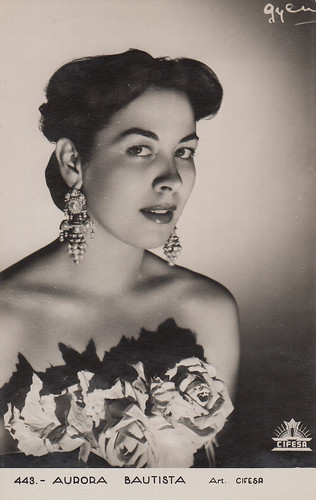
Spanish postcard, no. 443. Photo: Juan Gyenes / Cifesa.
Aurora Bautista (1925-2012) became a film star thanks to Locura de amor (1948), in which she played the mad queen Joanna of Castile. Until the mid-1970s, she was featured in about fifteen movies which include Pequeneces (1950), Condenados (1953), La gata (1956), Teresa de Jesus (1962), La tia Tula (1964), Pepa Doncel (1969) or Los pasajeros (1975). She also had a brilliant career on stage, appearing in plays by, for example, Shakespeare, Garcia Lorca, Tennessee Williams, Fernando Arrabal, ...

Spanish promotional postcard for Zampo y yo/Zampo and Me (Luis Lucia, 1966). Photo: Juan Gyenes /Época Films.
After having gained popularity in radio musical programs, Ana Belen (1951) signed in the mid-1960s a four-picture deal with Epoca Films, which hoped to turn her into a Marisol-like child star. She made her film debut in Zampo y yo (1966), alongside Fernando Rey, but it didn’t meet the expected success and the three other films were never produced. Fortunately, she quickly bounced back by turning to theatre acting under Miguel Narros’ guidance. It was the beginning of a long and impressive stage career. She came back to film in Espanolas in Paris (1971) and, this time, she found success. She then starred in, e.g., Morbo (1972), Vidal conyugal sana (1974), La peticion (1976), La oscura historia de la prima Montse (1977), Demonios en el jardin (1982), La corte de Faraon (1985), Divinas palabras (1987), El vuelo de la Paloma (1989), La pasion turca (1994), El amor prejudica seriamente la salud (1996), Antigua vida mia (2001), Cosas que hacen que la vida vulga la pena (2004), etc. On television, she notably was much appreciated in the big-budgeted series Fortunata y Jacinta (1980). She is also a renowned singer and received an honorary Latin Grammy Award for musical excellence in 2015.
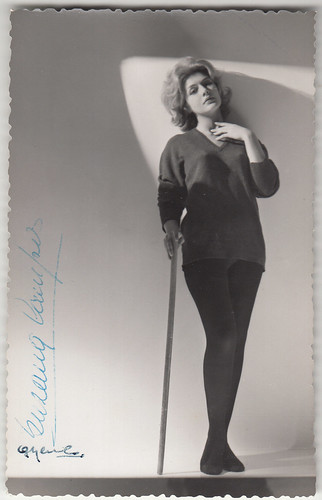
Spanish autographed postcard. Photo: Juan Gyenes.
Argentinian-born Susana Campos (1933-2004) starred in Argentinian and Spanish films. She got most of her leading parts from the mid-1950s to the end of the 1960s. She received a Best Actress Award from the 'Argentinian Film Critic Association' for Rosaura a las diez (1958) and her acting in El dia que me quieras (1969) gained her an Award from the American 'Association of Latin Entertainment Critics'. She also was active on stage.
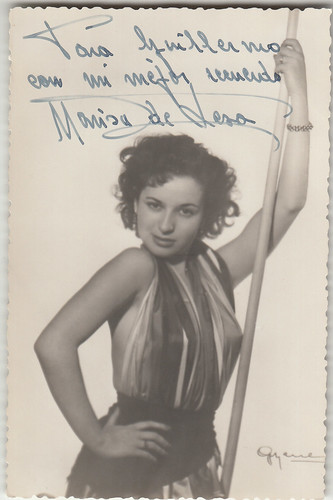
Spanish autographed postcard. Photo: Juan Gyenes.
Marisa De Leza (1933-2020) starred in Spanish films from the beginning of the 1950s to the beginning of the 1960s. She was featured in Surcos (1951), which is considered one of the best examples of Spanish neorealism, and received a Best Actress Award at the San Sebastian Film Festival for La patrulla (1954). She also performed on stage and on TV.

Spanish autographed postcard. Photo: Juan Gyenes.
Blanca De Silos (1914-2002) starred in Spanish films during the 1940s. They include Orosia (1943), Mariona Rebull (1947) and En un rincon de Espana (1949), which was the first production to use the Spanish Cinefotocolor process. After 1950, she was more active on stage.
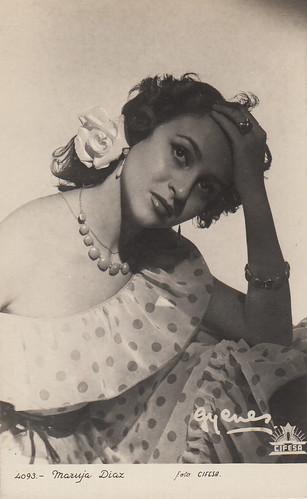
Spanish postcard, no. 4093. Photo: Juan Gyenes / Cifesa.
Marujita Diaz (1932-2015) became a film star thanks to Pueblo de las mujeres (1953). Until 1965, she was featured in fifteen more films such as El pescador de coplas (1954), El genio alegre (1957), Pelusa (1960), La casta Susana (1963) or La pergola de las flores (1965). Afterwards, she only appeared occasionally on screen. She was also a very popular stage performer, in variety shows and musicals. Furthermore, her disinhibited personality and her self-confidence enabled her to become a sought-after figure on various TV programs.

Spanish postcard by Ediciones Tarjefher, no. 220. Photo: Juan Gyenes.
Rocio Durcal (1944-2006) became a star thanks to her first film Cancion de juventud (1962), which made the best use of her musical talents. It was followed by other popular musicals such as Rocio de la Mancha (1963), Tengo 17 anos (1964), Mas bonita que ninguna (1965) or Buenos dias, condesita (1967). She played her first dramatic role in Cristina Guzman (1968) and then went back to musicals in Las Leandras (1969) and La novicia rebelde (1972). The dramas Marianela (1972) and Diselo con flores/Dites-le avec des fleurs (1974) were her two first movies in which she didn’t sing. In 1977, she played a lesbian in Me siento extrana, a role she regretted to have accepted. She then decided to give up film and to focus on her singing career. She soon specialised in a popular Mexican style of music known as 'ranchera' and became a true icon in that field, selling millions of records.

Spanish postcard by Ediciones Tarjefher, no. 110. Photo: Juan Gyenes.
Marisol (1948) became a hugely popular child star thanks to her film debut Un rayo de luz (1960), followed by, e.g., Tombola (1962) or Marisol rumbo a Rio (1963). In the second half of the 1960s, she matured into a ravishing young lady, without losing the audiences’ favour, and was featured in films such as Las 4 bodas de Marisol (1967) or Carola de dia, Carola de noche (1969). From 1973 on, she turned to dramatic roles and appeared for instance in La corrupcion de Chris Miller (1973), El poder del deseo (1975) or Los dias del pasado (1977). She retired after Caso cerrado (1985).
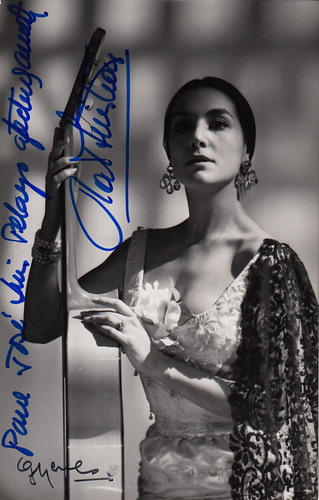
Spanish autographed postcard. Photo: Juan Gyenes.
Nati Mistral (1928-2017) was a multi-talented artist who had a brilliant career on stage. She starred in plays such as Garcia Lorca’s 'Bodas y sangre', Cocteau’s 'Les parents terribles', Jacinto Benavente’s 'La malquerida', Fernando de Rojas’ 'La Celestina' and Antonio Gala’s 'Cafe cantante' and in musicals such as Juan Ignacio Luca de Tena’s 'La Perrichola', Dale Wasserman’s 'Man of la Mancha' or Michael Stewart’s 'Hello Dolly'. She was a noted singer as well, with an interesting recording career which began in 1944, and gave poetry recitals. She also appeared in several films, especially at the end of the 1940s and the beginning of the 1950s. She notably was featured in Maria Fernanda, la Jerezana (1947), Currito de la Cruz (1949) and Cabaret (1953).

Spanish autographed postcard. Photo: Juan Gyenes.
Matilde Munoz Sampedro (1900-1969) was a popular character actress in films, from 1944 until her death, and on stage. She was famous director Antonio Juan Bardem’s mother. He gave her roles in several of his films, such as Comicos (1954), Calle Mayor (1956) or Nunca pasa nada (1963).
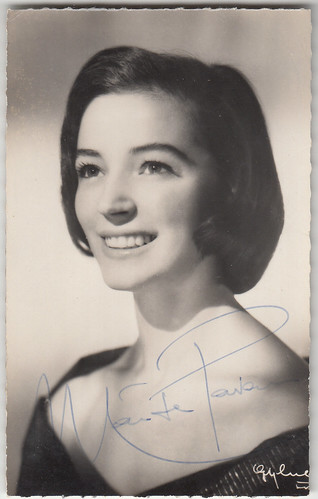
French postcard by Editions du Globe, Paris, no. 740. Photo: Juan Gyenes.
Italian-born Marisa Pavan (1932-2023) followed her twin sister Pier Angeli’s footsteps and became a star in her own right in the 1950s. Her Hollywood films include Drum Beat (1954), Down Three Dark Streets (1954), The Rose Tattoo (1955), Diane (1956) and The Midnight Story (1957).
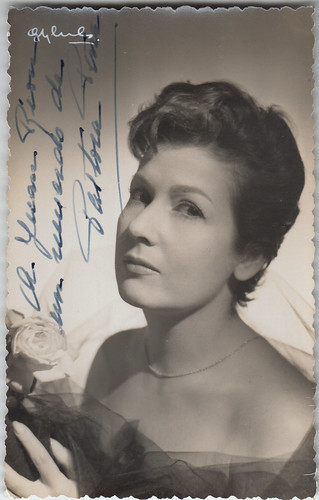
Spanish autographed postcard. Photo: Juan Gyenes.
In the 1940s, Pastora Pena (1920-2003) starred in Spanish movies such as Porque te vi llorar (1942), Lecciones de buen amor (1944) or Una noche en blanco (1949). During her long and impressive stage career, she notably had great success in Robert Anderson’s 'Tea and Sympathy' at the end of the 1950s.
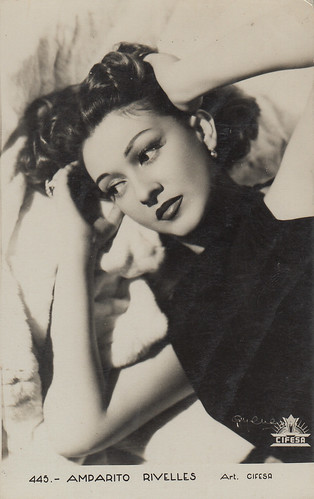
Spanish postcard, no. 445. Photo: Juan Gyenes / Cifesa.
Amparo Rivelles (1925-2013) was the daughter of famous actors Maria Teresa Ladron de Guevara and Rafael Rivelles. She followed in her parent’s footsteps and became a star upon her film debut in 1941 in the leading roles of Mari Juana and Alma de Dios. During her long and successful career, she was featured in Spanish and Mexican films. The 'Circulo de Escritores Cinematograficos' gave her a Best Actress Award for her performances in La Fe (1947) and Fuenteovejuna (1947) and she received a Goya Award in the same category for Hay que deshacer la casa (1986). She also played in the Spanish version of Orson Welles’ Mr. Arkadin (1955). She worked to great acclaim as well on stage and on TV.
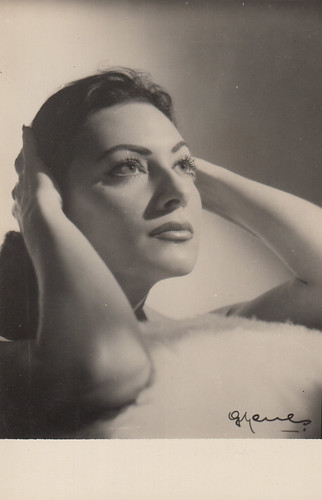
Spanish postcard. Photo: Juan Gyenes.
In the 1950s, Lina Rosales (1928) starred in Spanish movies such as Sierra maldita (1954), El puente del diablo (1956) or El pasado te acusa (1958). After Cancion da cuna (1961), in which she plays a nun who lovingly takes care of an abandoned little girl, she only occasionally acted in films. She also performed on stage.

Spanish postcard, no. 4089. Photo: Juan Gyenes / Cifesa.
After having starred at the beginning of the 1950s in Spanish films such as La nina de Luzmela (1950), El hijo de la noche (1950) and El negro que tenia el alma blanca (1951), Maria Rosa Salgado (1929-1995) went to the U.S.A. under the aegis of film producer Alexander Paal, who thought she had the makings of a Hollywood star. She spent several months learning English and a successful screen test soon prompted a movie contract offer. But she preferred to go back to Spain and marry her boyfriend, toreador Pepe Dominguin, in 1953. Later she occasionally appeared again on the screen, for example in Rapsodia de sangre (1958), Fuenteovejuna (1972) or Sonambulos (1978).
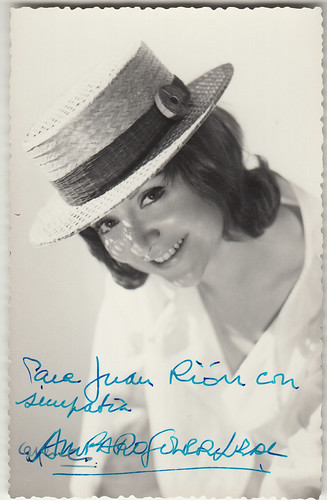
Spanish autographed postcard. Photo: Juan Gyenes.
Amparo Soler Leal (1933-2013) was a popular movie star in the 1960s, 1970s and 1980s. She twice received a Best Actress Award from the 'Circulo de Escritores Cinematograficos' for La gran familia (1962) and Bearn o la sala de las munecas (1983). She also got a Best Supporting Actress Award for Jo, papa! (1975). In 1984, she was directed by Pedro Almodovar in Qué he hecho yo para merecer esto! (1984). She performed on stage as well and formed her own company in the 1960s.
Text and postcards: Marlene Pilaete.
No comments:
Post a Comment